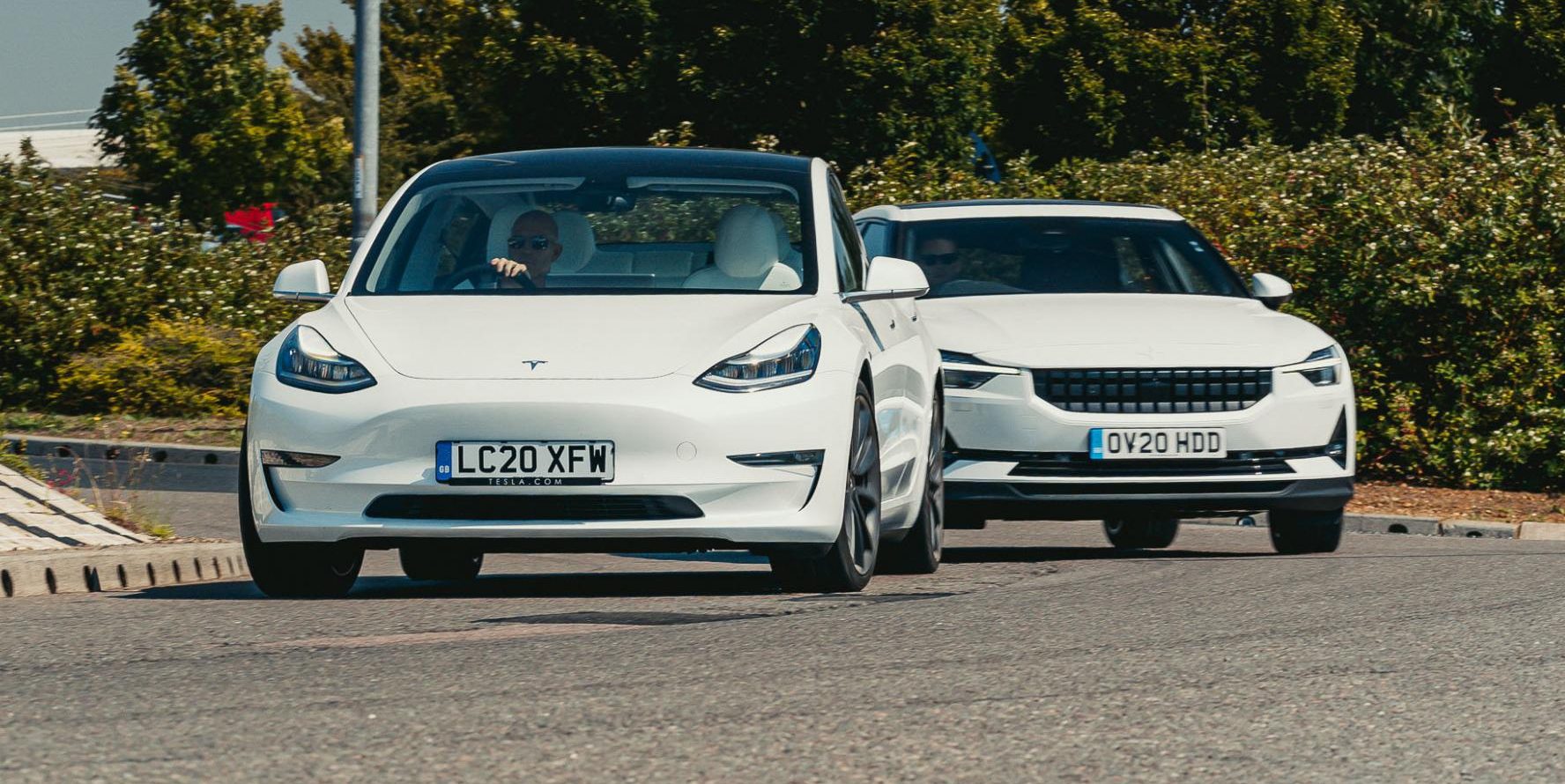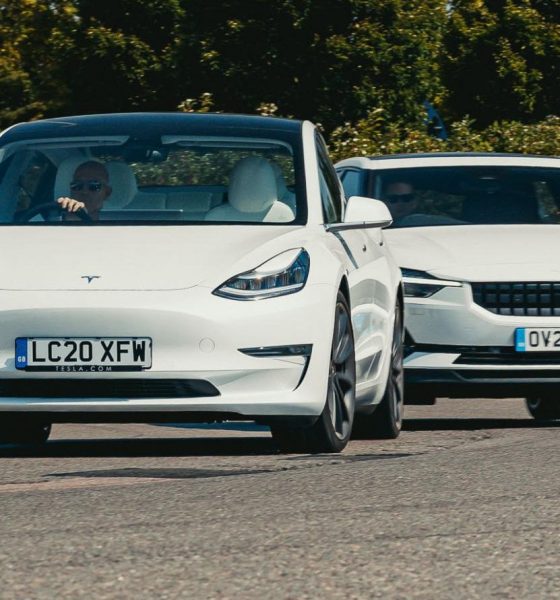The Tesla Model 3 and the Polestar 2 were recently pitted against each other by motoring outlet Top Gear. During the magazine’s review, the two vehicles were compared according to their efficiency, performance, and overall long trip capability, to name a new. As it turns out, it appears that the Polestar 2 is both the Model 3’s current biggest rival and strongest ally.
The Model 3 and the Polestar 2 are comparatively priced, with both vehicles commanding a price of about £600 per month in the UK. The two vehicles are also comparable when it comes to their batteries, with the Model 3 sporting a 75 kWh pack and the Polestar 2 being equipped with a 78 kWh unit. Consumption favors the Tesla during a 500-mile drive, however, as the Model 3 consumed 28.4 kW per 100 miles as opposed to the Polestar 2’s 35.7 kW per 100 miles. Part of this is due to the Polestar 2’s weight, which is about 595 lbs heavier than the Model 3.
That being said, when it comes to raw performance, the Model 3 proved to be far zippier than the Polestar 2, with the Tesla hitting 60 mph in 3.2 seconds and the Polestar 2 taking 4.4 seconds to hit highway speed. Top Gear then mentioned something quite interesting. During their test, they opted to put the Model 3 on Chill Mode for the most part while they were operating the vehicle. But even with Chill Mode, the Model 3 still made the Polestar 2 work hard to keep pace.
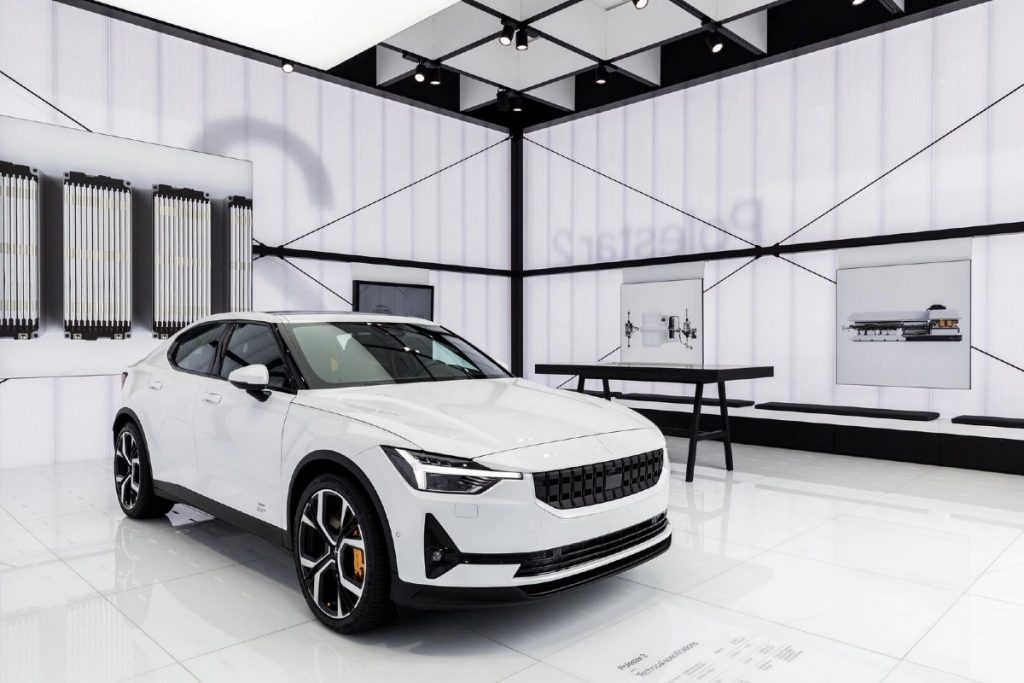
“This Tesla is the 450bhp Performance, and it pulled an easy ten lengths on the Polestar off every roundabout or away from each village, but we found ourselves driving it in power-reducing Chill mode most of the time, simply to escape the sudden, neck-straining step-off every time we gently pulled away. It’s very eager. Even in reverse, which is a bit disconcerting. Chill mode smoothed the throttle nicely and still made the Polestar work hard to keep pace,” the publication noted.
One thing that stands out is the fact that unlike the Model 3, which was built as an all-electric vehicle, the Polestar 2 is actually built on Volvo’s CMA architecture, which also underpins the popular XC40. The Polestar 2 is also made with steel panels, which are heavier than the aluminum that’s used in some parts of the Model 3. But despite this, the motoring publication noted that the Polestar, like the Tesla, does not feel heavy on the road at all, thanks to its low center of gravity.
Top Gear did state that there are some areas where the Model 3 falls beneath the Polestar 2. One of these is the vehicles’ interior quality, which is an area where Polestar excels in. Another concerns the two vehicles’ driving dynamics. The publication noted that the softer sprung Tesla gets a bit jiggled from side to side and it does not have impressive body control. The Model 3’s steering was also described as “pretty nasty,” as it has an initial resistance that fades as the driver turns.
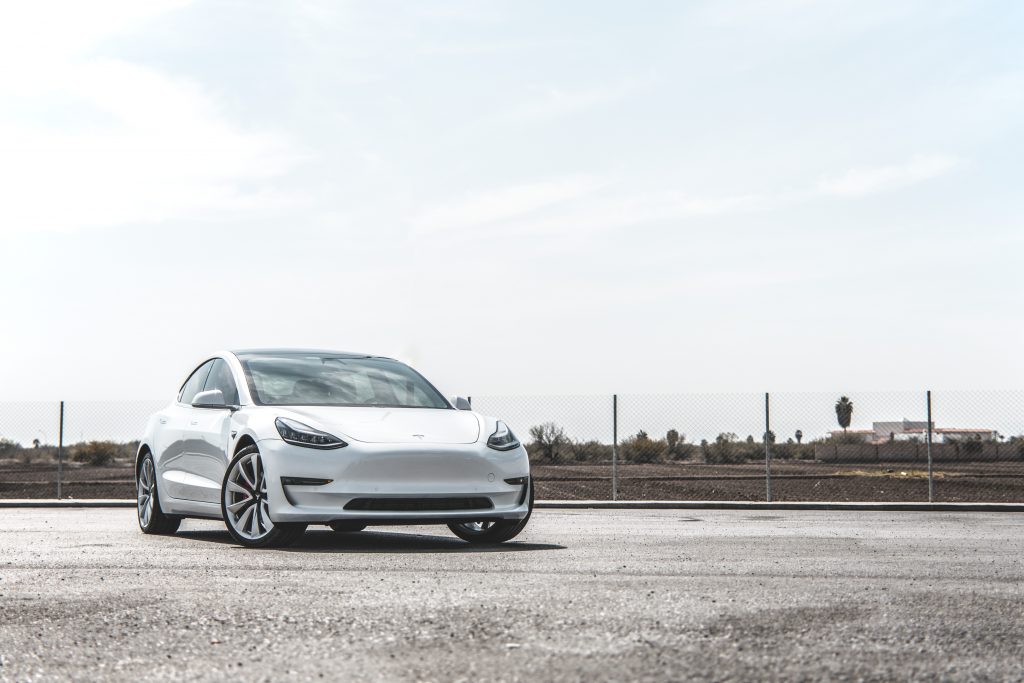
The publication noted that the Model 3’s steering could not be described as “sporty or involving,” just effective. On the other hand, the Polestar 2’s steering and controls were described as reassuring in the way that they are “meatier and more satisfying.” But despite these drawbacks, the Model 3 still rides more comfortably compared to the Polestar 2.
The two vehicles also compare very well when it comes to their tech, as the Polestar 2’s Google-powered software experience stands pretty well against Tesla’s custom OS for the Model 3. Both vehicles have robust driver-assist features as well, though Top Gear noted that both Tesla and Volvo’s autonomous efforts still have large areas for improvement. This is especially true for Tesla, which sells a Full Self-Driving suite for the Model 3. Both cars are capable of long-distance travel, thanks to the Supercharger Network and Polestar’s partnership with Plugsurfing. But between the two, the Model 3 provides a faster, easier charging experience.
Ultimately, the Polestar 2 is a stellar effort on Volvo’s part. It’s attractive, well-built, and it carries the best of Volvo’s tech and features in an all-electric package. That being said, Top Gear concluded that ultimately, the Model 3 would likely still be the vehicle to choose if one were looking for an electric car, simply because it provides a more complete ecosystem of ownership.
“The Polestar experience is still very Volvo – and there’s nothing wrong with that. No Volvo drives as well as this, nor oozes more Scandi calmness and cool. It’s pure hygge. I know this is less than analytical but I love what it stands for, what it looks like, it’s the one I’d rather be seen driving and yet… the Tesla wins. Given a straight choice between the two, that’s the one I’d drive away. Nothing to do with its speed or autonomy – the two things usually championed by the Teslarati – but because of its ease of use, efficiency, the supercharger network. It’s the more complete mode of transport,” the magazine noted.

News
Tesla dominates in the UK with Model Y and Model 3 leading the way

Tesla is dominating in the United Kingdom so far through 2025, and with about two weeks left in the year, the Model Y and Model 3 are leading the way.
The Model Y and Model 3 are the two best-selling electric vehicles in the United Kingdom, which is comprised of England, Scotland, Wales, and Northern Ireland, and it’s not particularly close.
According to data gathered by EU-EVs, the Model Y is sitting at 18,890 units for the year, while the Model 3 is slightly behind with 16,361 sales for the year so far.
The next best-selling EV is the Audi Q4 e-tron at 10,287 units, lagging significantly behind but ahead of other models like the BMW i4 and the Audi Q6 e-tron.
GOOD NEWS 🇬🇧 Tesla is absolutely crushing the UK electric vehicle market in 2025 💥
The numbers are in, and the dominance is clear. With an impressive amount of 42,270 vehicles delivered year-to-date, the brand now commands a solid 9.6% market share of the total auto market 🆒… pic.twitter.com/dkiGX9kzd0
— Ming (@tslaming) December 18, 2025
The Model Y has tasted significant success in the global market, but it has dominated in large markets like Europe and the United States.
For years, it’s been a car that has fit the bill of exactly what consumers need: a perfect combination of luxury, space, and sustainability.
Both vehicles are going to see decreases in sales compared to 2024; the Model Y was the best-selling car last year, but it sold 32,610 units in the UK. Meanwhile, the Model 3 had reached 17,272 units, which will keep it right on par with last year.
Tesla sold 50,090 units in the market last year, and it’s about 8,000 units shy of last year’s pace. It also had a stronger market share last year with 13.2 percent of the sales in the market. With two weeks left in 2025, Tesla has a 9.6 percent market share, leading Volkswagen with 8 percent.
The company likely felt some impact from CEO Elon Musk’s involvement with the Trump administration and, more specifically, his role with DOGE. However, it is worth mentioning that some months saw stronger consumer demand than others. For example, sales were up over 20 percent in February. A 14 percent increase followed this in June.
News
Tesla Insurance officially expands to new U.S. state
Tesla’s in-house Insurance program first launched back in late 2019, offering a new way to insure the vehicles that was potentially less expensive and could alleviate a lot of the issues people had with claims, as the company could assess and repair the damage itself.
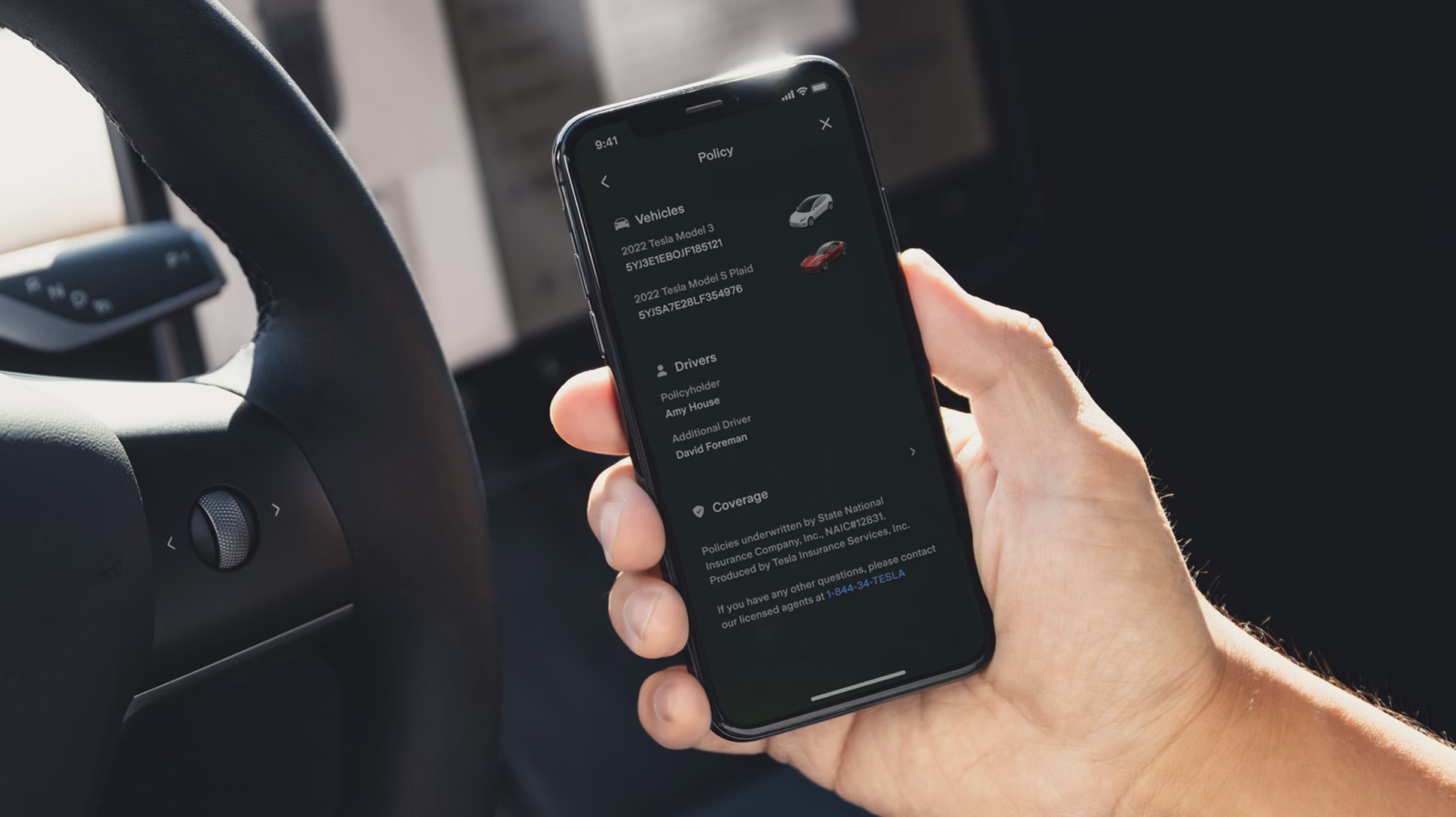
Tesla Insurance has officially expanded to a new U.S. state, its thirteenth since its launch in 2019.
Tesla has confirmed that its in-house Insurance program has officially made its way to Florida, just two months after the company filed to update its Private Passenger Auto program in the state. It had tried to offer its insurance program to drivers in the state back in 2022, but its launch did not happen.
Instead, Tesla refiled the paperwork back in mid-October, which essentially was the move toward initiating the offering this month.
BREAKING: Tesla Insurance has just officially launched in Florida.
This is the first new state to receive @Tesla Insurance in more than 3 years. In total, Tesla insurance is now available in 13 U.S. states (map in thread below of all the states).
Tesla Insurance in Florida uses… pic.twitter.com/bDwh1IV6gD
— Sawyer Merritt (@SawyerMerritt) December 17, 2025
Tesla’s in-house Insurance program first launched back in late 2019, offering a new way to insure the vehicles that was potentially less expensive and could alleviate a lot of the issues people had with claims, as the company could assess and repair the damage itself.
It has expanded to new states since 2019, but Florida presents a particularly interesting challenge for Tesla, as the company’s entry into the state is particularly noteworthy given its unique insurance landscape, characterized by high premiums due to frequent natural disasters, dense traffic, and a no-fault system.
Annual average premiums for Florida drivers hover around $4,000 per year, well above the national average. Tesla’s insurance program could disrupt this, especially for EV enthusiasts. The state’s growing EV adoption, fueled by incentives and infrastructure development, aligns perfectly with Tesla’s ecosystem.
Moreover, there are more ways to have cars repaired, and features like comprehensive coverage for battery damage and roadside assistance tailored to EVs address those common painpoints that owners have.
However, there are some challenges that still remain. Florida’s susceptibility to hurricanes raises questions about how Tesla will handle claims during disasters.
Looking ahead, Tesla’s expansion of its insurance program signals the company’s ambition to continue vertically integrating its services, including coverage of its vehicles. Reducing dependency on third-party insurers only makes things simpler for the company’s automotive division, as well as for its customers.
News
Tesla Full Self-Driving gets sparkling review from South Korean politician
“Having already ridden in an unmanned robotaxi, the novelty wasn’t as strong for me, but it drives just as well as most people do. It already feels like a completed technology, which gives me a lot to think about.”
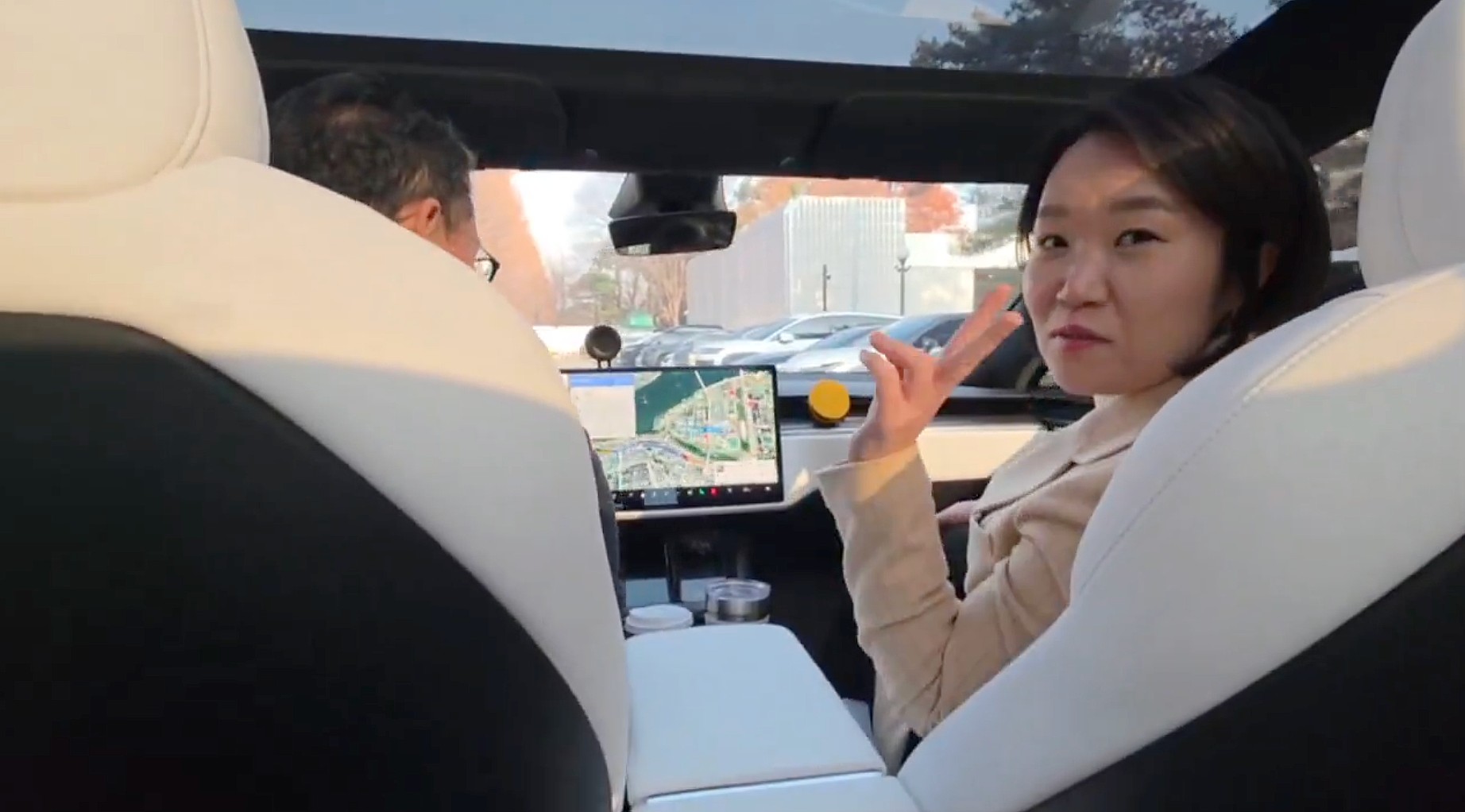
Tesla Full Self-Driving got its first sparkling review from South Korean politician Lee So-young, a member of the country’s National Assembly, earlier this week.
Lee is a member of the Strategy and Finance Committee in South Korea and is a proponent of sustainable technologies and their applications in both residential and commercial settings. For the first time, Lee was able to utilize Tesla’s Full Self-Driving technology as it launched in the country in late November.
Her thoughts on the suite were complimentary to the suite, stating that “it drives just as well as most people do,” and that “it already feels like a completed technology.”
드디어 오늘, 서울에서 테슬라 FSD 체험 했습니다.
JiDal Papa님의 모델S 협찬에 힘입어^^ 파파님 정말 감사합니다.
국회 -> 망원시장 -> 홍익대 -> 국회 복귀 코스였고요.
이미 무인 로보택시를 타봐서 그런지 신기함은
덜했지만, 웬만한 사람만큼 운전을 잘하네요.이미 완성된 기술이라고… pic.twitter.com/8pAidHBpRG
— 이소영 국회의원 (Soyoung Lee) (@im_soyounglee) December 17, 2025
Her translated post says:
“Finally, today I got to experience Tesla FSD in Seoul. Thanks to the Model S sponsored by JiDal Papa^^, I’m truly grateful to Papa. The route was from the National Assembly -> Mangwon Market -> Hongik University -> back to the National Assembly. Having already ridden in an unmanned robotaxi, the novelty wasn’t as strong for me, but it drives just as well as most people do. It already feels like a completed technology, which gives me a lot to think about. Once it actually spreads into widespread use, I feel like our daily lives are going to change a lot. Even I, with my license gathering dust in a drawer, don’t see much reason to learn to drive a manual anymore.”
Tesla Full Self-Driving officially landed in South Korea in late November, with the initial launch being one of Tesla’s most recent, v14.1.4.
It marked the seventh country in which Tesla was able to enable the driver assistance suite, following the United States, Puerto Rico, Canada, China, Mexico, Australia, and New Zealand.
It is important to see politicians and figures in power try new technologies, especially ones that are widely popular in other regions of the world and could potentially revolutionize how people travel globally.
